This site may contain links to affiliate websites, and I may earn a commission for any purchases made through those links at no additional cost to you.

Understanding Today’s Economy

Welcome to Our Analysis of Today’s Economy
As we navigate through 2025, the global economy is facing a mix of challenges and opportunities. While some regions are showing resilience, others are experiencing slower growth. Let’s dive into the key trends shaping our financial landscape.
Global Economic Growth is Expected to Stay Steady
Global economic growth is expected to stay steady, with global GDP forecasted to rise slightly to 3.3% in 2025 and maintain this level through 2026. In OECD nations, GDP growth is projected to be moderate compared to pre-pandemic levels, reaching 1.9% in both 2025 and 2026. Meanwhile, growth in non-OECD economies is also expected to remain largely consistent with current trends, with emerging Asian markets continuing to drive a significant portion of global expansion.
Regional Economic Trends
Different regions are experiencing varied economic trajectories. The U.S. is expected to grow at 2.8% in 2025, benefiting from a strong labor market and technological innovation. However, the euro area faces slower growth at 1.3%, primarily due to sluggish consumer spending and industrial production challenges. China’s growth is also slowing, with projections of 4.7% for 2025 as the country grapples with property market instability and policy shifts. Meanwhile, Japan’s economy is expected to expand by 1.5% this year, supported by government stimulus and export growth.
Challenges and Risks
Despite these growth projections, significant risks remain. Geopolitical tensions, trade uncertainties, and inflation continue to pose challenges. The ongoing conflict in Ukraine and potential escalations in the Middle East are key concerns. Additionally, supply chain disruptions and energy market fluctuations add layers of complexity to economic stability.
Economic Policy and Inflation
Central banks are playing a crucial role in managing inflation. The OECD expects inflation to ease to 3.8% in 2025, supported by monetary policy adjustments such as interest rate cuts and fiscal measures. However, not all central banks will meet their targets, and geopolitical uncertainty remains high. Countries with high public debt may struggle to balance economic growth and inflation control, leading to potential fiscal policy changes.
The Future of Work and Technological Impact
Another crucial factor influencing today’s economy is the evolving job market. Automation, artificial intelligence, and digital transformation are reshaping industries. While these technologies boost productivity, they also create workforce challenges, requiring reskilling initiatives and education system adjustments. The gig economy and remote work trends are further altering employment dynamics worldwide.
The Role of Sustainable Development
Sustainability is becoming an integral part of economic policies worldwide. Governments and corporations are investing in renewable energy, green technologies, and carbon-neutral initiatives to combat climate change and ensure long-term economic stability. Sustainable finance, including green bonds and ESG (Environmental, Social, and Governance) investments, is gaining momentum, influencing global markets and corporate strategies.
Consumer Behavior and Market Shifts
Changing consumer behavior is another key trend shaping today’s economy. Digital commerce continues to expand, with e-commerce sales projected to grow significantly in 2025. Consumers are increasingly prioritizing sustainability, ethical sourcing, and digital convenience when making purchasing decisions. Companies that adapt to these shifts by embracing digital transformation and sustainable practices will likely maintain a competitive edge.
Conclusion: A Resilient but Uncertain Economy
In conclusion, today’s economy is marked by resilience and uncertainty. While global growth continues, inflation control, geopolitical tensions, technological advancements, and sustainability initiatives will play key roles in shaping the financial landscape. As we move forward in 2025, it’s essential to monitor these trends and adapt to the evolving economic environment.




